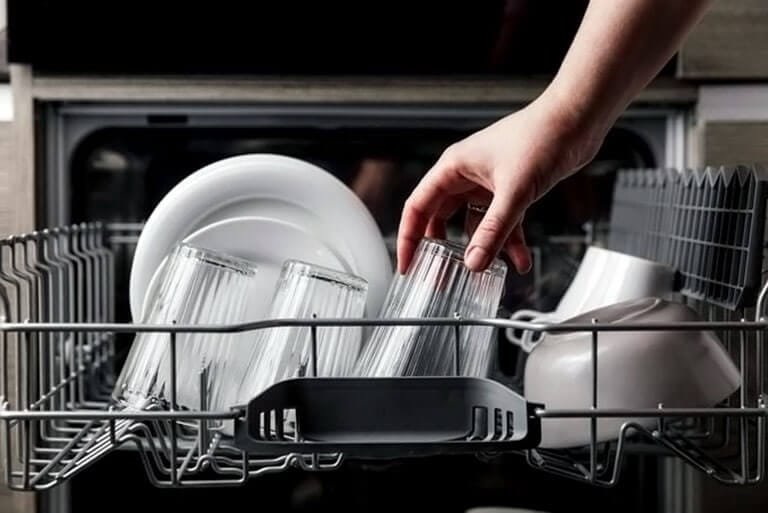You’ve just opened your dishwasher, expecting a rack full of sparkling, dry dishes, but instead, you’re greeted with a soggy mess. Frustrating, right?
You’re not alone. Many people face the same issue and wonder what’s going wrong. Is it a faulty machine or just a minor glitch that can be easily fixed? You’ll discover the common reasons why your dishwasher isn’t drying your dishes properly and learn simple solutions to get it back on track.
You’ll save time, avoid the hassle of hand-drying, and keep your dishes spotless and dry, just as they should be. Curious to find out how? Let’s dive in and solve this mystery together!
Common Causes
Dishwashers are a convenient home appliance. But sometimes they fail to dry dishes. Understanding common causes can help troubleshoot the problem. Below are some typical reasons why your dishwasher might not be drying dishes effectively.
Heating Element Issues
The heating element is crucial for drying dishes. A malfunction can prevent the dishwasher from generating enough heat. Check if the heating element is working. You can find it at the bottom of the dishwasher. Look for any visible signs of damage. A multimeter can test if it is functioning correctly. Replace it if it is broken.
Ventilation Problems
Proper ventilation is essential for drying dishes. The dishwasher needs to release steam. Blocked vents can trap moisture inside. This results in wet dishes. Inspect the vents for any obstructions. Make sure they are clear. Clean them regularly to maintain airflow.
Improper Loading
Loading dishes incorrectly can affect drying. Plates should not block the sprayer arms. Overloading the dishwasher can restrict air circulation. This can prevent dishes from drying. Arrange dishes with enough space between them. Ensure they are not touching each other. Proper loading helps air circulate and dry dishes efficiently.
Checking The Heating Element
Dishwashers save time and effort, but sometimes they leave dishes wet. A common cause is a problem with the heating element. This component warms the water and air inside the dishwasher, helping dishes dry. Understanding how to check and replace this element can restore your dishwasher’s drying performance.
Testing For Functionality
Start by unplugging the dishwasher for safety. Locate the heating element, usually at the bottom of the tub. Check for visible damage like cracks or breaks. Use a multimeter to test the element’s functionality. Set the multimeter to the resistance setting. Touch the probes to the element’s terminals. A functional element shows a reading of between 15 and 30 ohms. A reading outside this range means the element is faulty.
Replacing A Faulty Element
If the heating element is faulty, replacement is necessary. Purchase a compatible element for your dishwasher model. Unplug the dishwasher and remove the lower panel. Disconnect the wires from the terminals. Unscrew the mounting brackets or nuts holding the element in place. Carefully remove the old element. Install the new element by reversing the removal steps. Ensure all connections are secure. Test the dishwasher to confirm the new element works correctly.
Improving Air Circulation
Improving air circulation can boost your dishwasher’s drying performance. Many dishwashers struggle with drying because air cannot circulate freely. This issue often stems from poor ventilation or clogged vents. Addressing these problems can enhance drying efficiency.
Ensuring Proper Ventilation
Proper ventilation helps dishes dry faster. Check if your dishwasher’s venting system functions correctly. A blocked vent prevents air from circulating. Ensure the vent is open and unobstructed. This allows steam to escape and air to circulate.
Cleaning The Vent
Regular vent cleaning improves air circulation. Dust and debris often accumulate, hindering airflow. Use a damp cloth to wipe the vent clean. Removing buildup ensures air moves freely. A clean vent supports optimal drying performance.
Correct Loading Techniques
Dishwasher leaving dishes wet? Arrange items properly for better drying. Ensure dishes aren’t touching each other. Allow space for air circulation. Place plastic items on the top rack to prevent water pooling. Check that nothing blocks the spray arms. Proper loading enhances drying efficiency.
Correct loading techniques can make a significant difference in how well your dishwasher dries your dishes. A common issue many people face is finding their dishes still wet after a cycle. However, understanding how to load your dishwasher properly can greatly improve drying efficiency. Let’s dive into some effective methods that can help you achieve spotless, dry dishes every time.
Arranging Dishes For Better Drying
Proper arrangement of dishes is key to ensuring they dry effectively. Place larger items like pots and pans on the sides and back so they don’t block the water spray. Make sure each dish has space around it. This allows hot air to circulate freely, facilitating better drying. Tilt dishes slightly, as this encourages water to run off instead of pooling. Plates should face the center of the dishwasher, and bowls should lean slightly forward. This positioning allows water to drain off easily during the drying cycle.
Avoiding Overloading
Overloading your dishwasher is a common mistake that can lead to wet dishes. When you cram too many items in, it restricts airflow and water movement. This can result in inefficient drying and even leave your dishes dirty. Think about a time when you were in a rush and filled the dishwasher to the brim. Did you notice that some dishes were still wet or not entirely clean? Keeping this in mind can help you resist the urge to overload your dishwasher for the sake of convenience. Consider running two smaller loads instead of one overloaded cycle. This ensures that each dish has the space it needs for effective cleaning and drying. Your patience will pay off with sparkling, dry dishes. Taking a few extra moments to load your dishwasher correctly can save you time and frustration later. Experiment with these techniques and notice the difference in your dishwasher’s performance. What small change will you make the next time you load your dishwasher?
Using Rinse Aid Effectively
Rinse aid can help dry dishes more effectively. It prevents water spots and speeds up drying. Ensure your dishwasher’s rinse aid compartment is filled for best results.
Using Rinse Aid Effectively Is your dishwasher leaving your dishes wet and spotty? You might not be using rinse aid effectively. This simple yet powerful solution can dramatically improve your dishwasher’s performance.
Benefits Of Rinse Aid
Rinse aid helps water slide off dishes. This speeds up the drying process. You’ll notice fewer water spots, especially on glassware. It also prevents droplets from clinging to dishes. Your dishes will emerge sparkling clean and dry. Rinse aid can extend the life of your dishwasher. It reduces mineral deposits that can damage your machine over time.
Proper Usage Tips
First, locate the rinse aid compartment in your dishwasher. It’s usually near the detergent dispenser. Fill it up but don’t overdo it. Too much rinse aid can leave a residue. Check your dishwasher’s manual for specific instructions. Some machines allow you to adjust the rinse aid amount. Observe your dishes after a few cycles. Are they drying better? Adjust the amount as needed for optimal results. If you’ve never used rinse aid, give it a try. Are you ready to see the difference it makes?
Dishwasher Not Drying Dishes [Here is the Maintenance Tips]

Dishwashers save time and effort in every kitchen. But a common issue is dishes not drying properly. This problem often arises from neglecting simple maintenance. Regular care ensures your dishwasher works efficiently. Here are some practical maintenance tips. These will help keep your dishwasher in top condition.
Regular Cleaning
Regular cleaning is vital for a dishwasher’s performance. Start by wiping the door seals. These areas often collect food particles. Use a damp cloth and mild detergent. Clean the spray arms to remove clogs. Food debris can block water flow. Remove and rinse them under running water.
Check the filter regularly. A dirty filter can reduce drying efficiency. Remove it and wash under warm, soapy water. Scrub gently with a brush. This prevents food particles from recirculating. Keep the interior clean too. Run an empty cycle with vinegar monthly. It helps in removing odors and mineral deposits.
Routine Inspections
Routine inspections catch problems early. Examine the heating element for damage. A faulty element can cause drying issues. Look for visible cracks or breaks. Replace it if needed. Inspect the rinse aid dispenser. A broken dispenser can affect drying performance. Ensure it functions correctly.
Check the vent system for blockages. A blocked vent prevents moisture escape. Clear any obstructions regularly. Examine the float switch. It controls water level inside the dishwasher. Make sure it moves freely. A stuck float switch can disrupt cycles.
Professional Help
Sometimes, a dishwasher may not dry dishes due to complex issues. These problems might need an expert’s touch. If basic troubleshooting fails, professional help is essential. Technicians have the skills to identify the root cause. They can fix the problem efficiently, ensuring your dishwasher works perfectly.
When To Call A Technician
Several signs indicate the need for a technician. If water pools at the bottom, call for help. Strange noises during drying also need professional attention. Persistent issues after troubleshooting mean it’s time for a technician. They have tools and training to resolve these problems.
Choosing The Right Service
Not all services offer the same quality. Look for certified and experienced technicians. They provide reliable repairs and ensure lasting solutions. Check reviews and ratings online. Positive feedback often indicates trustworthy service. Also, consider their response time. Quick service means less downtime for your dishwasher.
Frequently Asked Questions
Why Is My Dishwasher Not Drying Dishes?
Check for clogged vents. Ensure heated dry settings are on. Inspect the drying fan for damage.
How Can I Fix A Dishwasher That Won’t Dry?
Clean the vent. Use rinse aid. Check the heating element for faults. Adjust settings accordingly.
Is A Faulty Heating Element Causing Wet Dishes?
Yes, a broken heating element stops heat circulation. Inspect it for damage or call a technician.
What Role Does Rinse Aid Play In Drying?
Rinse aid helps water slide off dishes, speeding up drying. Ensure your dishwasher has enough.
Does Dishwasher Maintenance Affect Drying?
Regular cleaning and maintenance ensure efficient drying. Remove debris from filters and check spray arms.
Conclusion
Fixing a dishwasher that doesn’t dry can be simple. Start with checking the rinse aid level. This small step often solves the problem. Next, ensure the heating element works properly. Sometimes, resetting the dishwasher can help. Clean the filters regularly to avoid clogs.
These steps usually improve drying performance. If issues persist, consider a professional repair. Regular maintenance keeps your dishwasher running smoothly. Ensures your dishes are always dry. A little effort goes a long way in maintaining efficiency. Happy dishwashing!
